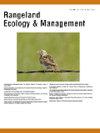合作保护行动改善两州独特种群区内的鼠兔种群表现
IF 2.4
3区 环境科学与生态学
Q2 ECOLOGY
引用次数: 0
摘要
制定一个强大的监测框架,结合与种群生存能力相关的合作保护和恢复行动的效果评估,对于目标生态系统和物种的长期成功恢复至关重要。然而,由于生态系统过程的复杂性和动态性以及目标物种种群动态评估的实际局限性,通常很难量化保护行动的效果。在此,我们提出了一个分析框架,利用横跨内华达州和加利福尼亚州边界的双州独特种群区段内的大松鸡(Centrocercus urophasianus,以下简称大松鸡)来量化保护行动的效果。该框架利用了一个基于网络的资料库,其中包含了在鼠茅草生态系统中开展的保护工作,并且很容易与当代的鼠茅草保护设计战略相匹配。我们在贝叶斯框架内采用了一个状态空间模型来估算丰度(N),作为渐进变化前后-控制-影响配对序列(BACIPS)设计的输入。尽管双州的鼠兔种群数量持续下降,但来自 57 个沙丘(2003-2021 年间监测)的计数数据以及 85 项独特行动(2012-2019 年间启动)提供了明确的证据,表明保护工作平均每年增加 4.4% 的种群丰度,因此自 2012 年以来,预测的种群丰度比未采取任何行动时高出 37.4%。根据保护行动的类型和实施后的滞后年数,种群丰度的增加也各不相同。本文章由计算机程序翻译,如有差异,请以英文原文为准。
Cooperative Conservation Actions Improve Sage-Grouse Population Performance Within the Bi-State Distinct Population Segment
Developing a robust monitoring framework that integrates efficacy assessments of cooperative conservation and restoration actions in relation to population viability is critical for successful long-term recovery of target ecosystems and species. However, often it is difficult to quantify conservation action efficacy because of the complex, dynamic nature of ecosystem processes and practical limitations associated with assessing target species’ population dynamics. Here, we present an analytical framework that allows for quantification of conservation action efficacy using greater sage-grouse (Centrocercus urophasianus; hereafter, sage-grouse) within the Bi-State Distinct Population Segment which spans the border of Nevada and California. This framework utilizes a web-based repository of conservation efforts carried out in sagebrush ecosystems and readily fits within contemporary sagebrush conservation design strategies. We employed a state-space model within a Bayesian framework to estimate abundance (N) as inputs for a progressive change before-after-control-impact paired series (BACIPS) design. Although sage-grouse populations continue to decline in the Bi-State, count data from 57 leks (monitored between 2003–2021) coupled with 85 unique actions (initiated between 2012–2019) provided clear evidence that conservation efforts increased population abundance, on average, by 4.4% annually, resulting in a predicted population abundance that was 37.4% greater than if no actions had occurred, since 2012. Population gains varied by the type of conservation action and according to the number of lag years following its implementation.
求助全文
通过发布文献求助,成功后即可免费获取论文全文。
去求助
来源期刊

Rangeland Ecology & Management
农林科学-环境科学
CiteScore
4.60
自引率
13.00%
发文量
87
审稿时长
12-24 weeks
期刊介绍:
Rangeland Ecology & Management publishes all topics-including ecology, management, socioeconomic and policy-pertaining to global rangelands. The journal''s mission is to inform academics, ecosystem managers and policy makers of science-based information to promote sound rangeland stewardship. Author submissions are published in five manuscript categories: original research papers, high-profile forum topics, concept syntheses, as well as research and technical notes.
Rangelands represent approximately 50% of the Earth''s land area and provision multiple ecosystem services for large human populations. This expansive and diverse land area functions as coupled human-ecological systems. Knowledge of both social and biophysical system components and their interactions represent the foundation for informed rangeland stewardship. Rangeland Ecology & Management uniquely integrates information from multiple system components to address current and pending challenges confronting global rangelands.
 求助内容:
求助内容: 应助结果提醒方式:
应助结果提醒方式:


